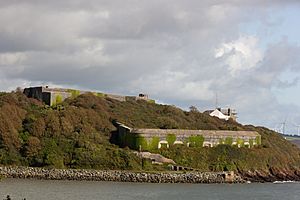Fort Hubberstone facts for kids
Quick facts for kids Fort Hubberstone |
|
|---|---|
| Milford Haven Wales |
|

View of Hubberstone Fort from Gelliswick beach
|
|
| Lua error in Module:Location_map at line 420: attempt to index field 'wikibase' (a nil value). | |
| Site information | |
| Owner | Private |
| Open to the public |
No |
| Site history | |
| Built | 1860-63 |
| In use | Derelict |
| Materials | Stone |
Fort Hubberstone is an old military fort located on the west side of the Milford Haven Waterway in Pembrokeshire, Wales. It is a very important historical building, listed as a Grade II* building. This fort was part of a series of defenses built to protect the important waterway. It worked together with Popton Fort on the opposite side of the water. Together, they created a strong defense, acting as the last line of protection for the Royal Naval dockyard at Pembroke Dock.
Contents
Fort Hubberstone: A Coastal Defender
Fort Hubberstone was built between 1860 and 1863. It cost about £55,000, which was a huge amount of money back then. This fort was designed as a large battery. It had eleven guns placed inside protected rooms called casemates. There were also eight more guns in an open area above the fort. Another nine guns were in a separate open battery on the side.
Fort Design and Protection
The fort has a special D-shape. It was built with a very strong, bomb-proof roof. This roof protected the barracks and other buildings inside from bombs dropped from above. On the land side, the fort was protected by a deep ditch. On the sea side, it had a special wall called a counter-scarp gallery. A separate casemate battery, which also held guns, was located a bit further down the headland.
Life at the Fort
The barracks inside Fort Hubberstone could house up to 250 soldiers. These soldiers often came from groups like the Royal Pembrokeshire Artillery. However, it was sometimes hard to get new soldiers because the fort was in an isolated area. It wasn't as appealing as forts in bigger towns.
Soldiers at the fort often practiced firing the large guns. In 1894, they even took part in experiments. They used searchlights to light up targets at night. This helped them practice shooting accurately even in the dark.
What Happened to the Fort?
After World War I, Fort Hubberstone was no longer actively used by the military. This was due to changes in how the army was organized. There was a suggestion in 1919 to turn the fort into homes for people, but this plan never happened.
Fort Hubberstone in World War II
During World War II, the fort was used again. It served as a shelter during air raids. It also became a camp for American military personnel. This shows how important its strong structure was during wartime.
The Fort Today
Today, Fort Hubberstone is no longer in use and has fallen into disrepair. It is owned by the Milford Haven Port Authority. There have been several ideas to fix up the fort, but none have worked out so far.
The fort is not currently open to the public. It can be dangerous to visit without permission. In 2011, a group called British Archaeology said it was one of the most endangered historical sites in the UK. This led to efforts to find a way to use the site for a long time. In 2019, there were plans to turn it into a place for former service members. These plans were later stopped. In September 2020, a private investor bought the site. They announced plans to open it to the public as a "living ruin."

